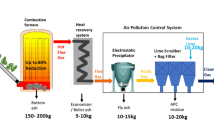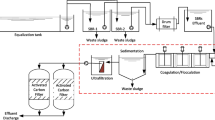Abstract
Cutting-edge research introduces a chemical reactor for liquid radioactive waste treatment, utilizing a four-stage radiochemical separation. Biomass conversion yielded activated carbons with impressive adsorption capacities up to 1 × 104 Bq/g and proved effective for Cs removal. Standout coagulants, AlCl3·6H2O and FeSO4·7H2O, achieved an 80% decontamination factor for six radionuclides. Sulphonated DVB ion-exchange resins showed high efficiency, achieving 100% Cs decontamination at pH 4 ± 2. Integrated processes successfully decontaminated twelve radionuclides up to 99 ± 1% with substantial demineralization of waste, up to 95%, was achieved. Current reactor system is invaluable for routine and emergency scenarios for treating liquid radioactive waste with varying radionuclide compositions.


















Similar content being viewed by others
References
Mehboob K, Aljohani MS (2018) Estimation of radioactivity released from CHASNUPP-1 nuclear power plant during loss of coolant accident. Int J Nucl Energy Sci Technol 12:111–126. https://doi.org/10.1504/IJNEST.2018.094280
Aruna Chandrasekhar (2023) COP28: Key outcomes agreed at the UN climate talks in Dubai. https://www.carbonbrief.org/author/arunachandrasekhar/
Bull PS (1974) Removal of strontium and cesium from radioactive waste waters by coagulation-flocculation of ferric hydroxide. 46
Rahman ROA, Metwally SS, El-Kamash AM (2019) Life cycle of ion exchangers in nuclear industry: application and management of spent exchangers. In: Martinez L, Kharissova O, Kharisov B (eds) Handb Ecomater
Mehboob K, Al-Zahrani YA, Aljohani MS, Alhawsawi A (2021) Primary coolant activity of 54Mn, 59Fe, 58Co, 60Co, and 51Cr in system integrated small and modular reactor. Ann Nucl Energy 160:108356. https://doi.org/10.1016/j.anucene.2021.108356
International Atomic Energy Agency (2022) Modular design of processing and storage facilities for small volumes of low and intermediate level radioactive waste including disused sealed sources. 183
Khan M, Um W, Han S, Kang J (2022) Kinetics and mechanism of rhenium-ethylenediaminetetraacetic acid ( Re ( IV ) -EDTA ) complex degradation; For 99 Tc-EDTA degradation in the natural environment. Environ Technol Innov 27:102492. https://doi.org/10.1016/j.eti.2022.102492
Neeb K-H (2011) The radiochemistry of nuclear power plants with light water reactors. Walter de Gruyter
Milyutin VV, Nekrasova NA, Kaptakov VO, Kozlitin EA (2023) Adsorption techniques for decontaminating liquid radioactive waste and radionuclide-contaminated natural water. Adsorption 29:323–334
Kim KW, Shon WJ, Oh MK et al (2019) Evaluation of dynamic behavior of coagulation-flocculation using hydrous ferric oxide for removal of radioactive nuclides in wastewater. Nucl Eng Technol 51:738–745. https://doi.org/10.1016/j.net.2018.11.016
Adeola AO, Iwuozor KO, Akpomie KG et al (2023) Advances in the management of radioactive wastes and radionuclide contamination in environmental compartments: a review. Environ Geochem Health 45:2663–2689. https://doi.org/10.1007/s10653-022-01378-7
IAEA (1992) Chemical precipitation processes for the treatment of aqueous radioactive waste.
Osmanlioglu AE (2018) Decontamination of radioactive wastewater by two-staged chemical precipitation. Nucl Eng Technol 50:886–889. https://doi.org/10.1016/j.net.2018.04.009
Mohamad NA, Hamzah S, Harun MHC et al (2022) Copperas as iron-based coagulant for water and wastewater treatment: A review. Biointerface Res Appl Chem 12:4155–4176. https://doi.org/10.33263/BRIAC123.41554176
Al-Abri M, Dakheel A, Tizaoui C, Hilal N (2010) Combined humic substance and heavy metals coagulation, and membrane filtration under saline conditions. Desalination 253:46–50
Mólgora CC, Domínguez AM, Avila EM et al (2013) Removal of arsenic from drinking water: a comparative study between electrocoagulation-microfiltration and chemical coagulation-microfiltration processes. Sep Purif Technol 118:645–651
Yonge D (2012) A comparison of aluminum and iron-based coagulants for a comparison of aluminum and iron-based coagulants for treatment of surface water in Sarasota county, Florida treatment of surface water in SARASOTA county, Florida. SSRN Electron J 1–209
Ahmad SS, Haq EU (2007) Pilot scale study of a chemical treatment process for decontamination of aqueous radioactive waste of Pakistan Research Reactor-1 Farooq Jan Health Physics Division Pakistan Institute of Nuclear Science & Technology, P. O. Nilore, Islamabad
Mahrous SS, Mansy MS, Galil EAA (2022) Decontamination of 137 Cs, 95 Zr, 154 Eu and 144 Ce from aqueous solutions using polyacrylamide titanium tungstosilicate. J Radioanal Nucl Chem. https://doi.org/10.1007/s10967-022-08583-9
Patel H (2019) Fixed-bed column adsorption study: a comprehensive review. Appl Water Sci. https://doi.org/10.1007/s13201-019-0927-7
Omar HA, Moloukhia H (2008) Use of activated carbon in removal of some radioisotopes from their waste solutions. J Hazard Mater 157:242–246. https://doi.org/10.1016/j.jhazmat.2007.12.108
El-Sayed GO, Yehia MM, Asaad AA (2014) Assessment of activated carbon prepared from corncob by chemical activation with phosphoric acid. Water Resour Ind 7–8:66–75. https://doi.org/10.1016/j.wri.2014.10.001
Heidarinejad Z, Dehghani MH, Heidari M et al (2020) Methods for preparation and activation of activated carbon: a review. Environ Chem Lett 18:393–415
Kong J, Yue Q, Huang L et al (2013) Preparation, characterization and evaluation of adsorptive properties of leather waste based activated carbon via physical and chemical activation. Chem Eng J 221:62–71. https://doi.org/10.1016/j.cej.2013.02.021
Fallah N, Taghizadeh M (2020) Continuous fixed-bed adsorption of Mo(VI) from aqueous solutions by Mo(VI)-IIP: Breakthrough curves analysis and mathematical modeling. J Environ Chem Eng 8:104079. https://doi.org/10.1016/j.jece.2020.104079
Moloukhia HWS, Hegazy E-G, SSM, (2016) Removal of Eu3+, Ce3+, Sr2+, Cs+ ions from radioactive waste solution by modified activated carbon prepared from coconut shells. Chem Ecol 32:324–345
Zakaria R, Jamalluddin NA, Abu Bakar MZ (2021) Effect of impregnation ratio and activation temperature on the yield and adsorption performance of mangrove based activated carbon for methylene blue removal. Results Mater 10:100183. https://doi.org/10.1016/j.rinma.2021.100183
Guo J, Lua AC (2003) Textural and chemical properties of adsorbent prepared from palm shell by phosphoric acid activation. Mater Chem Phys 80:114–119. https://doi.org/10.1016/S0254-0584(02)00383-8
Danish M, Hashim R, Ibrahim MNM, Sulaiman O (2013) Effect of acidic activating agents on surface area and surface functional groups of activated carbons produced from Acacia mangium wood. J Anal Appl Pyrolysis 104:418–425. https://doi.org/10.1016/j.jaap.2013.06.003
Yorgun S, Vural N, Demiral H (2009) Preparation of high-surface area activated carbons from Paulownia wood by ZnCl2 activation. Microporous Mesoporous Mater 122:189–194. https://doi.org/10.1016/j.micromeso.2009.02.032
Montazer M, Montazer D (2009) Radioactive waste management of nuclear power plants. Trans Am Nucl Soc 100:175
Khan M, Um W, Kim W-S et al (2018) Synthesis of rhenium-doped tin dioxide for technetium radioactive waste immobilization. J Nucl Mater 505:134–142. https://doi.org/10.1016/j.jnucmat.2018.04.014
Al Lafi AG, Al Abdullah J (2015) Cesium and cobalt adsorption on synthetic nano manganese oxide: a two dimensional infra-red correlation spectroscopic investigation. J Mol Struct 1093:13–23
Singare PU, Lokhande RS, Madyal RS (2011) Thermal degradation studies of some strongly acidic cation exchange resins. Open J Phys Chem 1:45–54
Prekob Á, Hajdu V, Muránszky G et al (2020) Application of carbonized ion exchange resin beads as catalyst support for gas phase hydrogenation processes. React Kinet Mech Catal 129:85–94
Ghosh S, Dhole K, Tripathy MK et al (2015) FTIR spectroscopy in the characterization of the mixture of nuclear grade cation and anion exchange resins. J Radioanal Nucl Chem 304:917–923
Coles CA, Yong RN (2002) Aspects of kaolinite characterization and retention of Pb and Cd. Appl Clay Sci 22:39–45
Kocaoba S (2007) Comparison of Amberlite IR 120 and dolomite’s performances for removal of heavy metals. J Hazard Mater 147:488–496
Hamed MM (2014) Sorbent extraction behavior of a nonionic surfactant, Triton X-100, onto commercial charcoal from low level radioactive waste. J Radioanal Nucl Chem 302:303–313
Zhu L, Liu Y, Chen J (2009) Synthesis of N-methylimidazolium functionalized strongly basic anion exchange resins for adsorption of Cr (VI). Ind Eng Chem Res 48:3261–3267
Jha MK, Van Nguyen N, Lee J et al (2009) Adsorption of copper from the sulphate solution of low copper contents using the cationic resin Amberlite IR 120. J Hazard Mater 164:948–953
Acknowledgements
The authors are thankful to Director General PINSTECH for providing necessary funding and support for the completion of this research work. Moreover, we are thankful to Head Research Reactor 1 for providing coolant during testing of the radioactive waste treatment reactor.
Author information
Authors and Affiliations
Corresponding author
Ethics declarations
Conflict of interest
The authors declare that there is no financial or any other competing interest.
Additional information
Publisher's Note
Springer Nature remains neutral with regard to jurisdictional claims in published maps and institutional affiliations.
Supplementary Information
Below is the link to the electronic supplementary material.
Rights and permissions
Springer Nature or its licensor (e.g. a society or other partner) holds exclusive rights to this article under a publishing agreement with the author(s) or other rightsholder(s); author self-archiving of the accepted manuscript version of this article is solely governed by the terms of such publishing agreement and applicable law.
About this article
Cite this article
Khan, M., Usman, M., Khan, H. et al. Development and testing of four stage chemical reactor (FSCR) for decontamination of liquid radioactive waste. J Radioanal Nucl Chem 333, 2793–2811 (2024). https://doi.org/10.1007/s10967-024-09491-w
Received:
Accepted:
Published:
Issue Date:
DOI: https://doi.org/10.1007/s10967-024-09491-w




